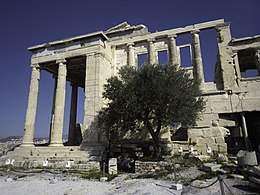Moria (tree)

In ancient Greece, the moriai (plural of moria) were olive trees considered to be the property of the state because of their religious significance.
Overview
From Attic Orators, vol. I. p. 289:
Throughout
Akademos and comprised a sacred grove. These trees, we are told by our ancient sources, were called moriai. The etymology remains obscure, but the most compelling explanation is the connection of the word moria with the stem μερ, which bears the meaning "to be part of"; the moriai were part of Athena's property.[2]
Mythical origin of moria (olive) trees in ancient Greece
Contest for Attica (Athens)
According to

From Olive Oil Times, Laura Aitken-Burt writes:
The Athenians chose Athena's gift and the olive tree has remained a central part of Greek life ever since for all of its profound qualities. The leaves have been used to crown the heads of victorious athletes, generals and kings, the wood used to construct houses and boats, the oil used to give fuel to lamps, rubbed into the toned, muscled bodies of lithe athletes, added to all food dishes and the olives themselves—a staple in the Mediterranean diet and a valuable export throughout antiquity and today. Even the iconic Athenian tetradrachm coins had the leaves of the olive branch peeping to the left of Athena's owl.[3]
References
- ^ The Oedipus Coloneus of Sophocles. CUP Archive. 1914. p. 155.
Attic Orators, vol. I. p. 289.
- ISBN 9780199694006.
- ^ Laura, Aitken-Burt (2015-03-10). "Sacred Olives: Athena's Tree on the Acropolis". Olive Oil Times. Retrieved 2017-05-02.
